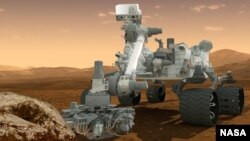NASA's Mars Science Laboratory mission is shifting gears. The Curiosity rover is going to take a break from drilling into Martian bedrock and analyzing rock samples to do what Mars rovers are made to do: drive across the terrain.
The U.S. space agency says this will be the biggest turning point since Curiosity landed on the Red Planet last August.
Martian Mission
Curiosity is exploring within a deep, 150-kilometer-wide depression called Gale Crater so that scientists can learn about the area's environmental history. The rover soon will shift into distance-driving mode to make the 8-kilometer trek to the base of a Martian peak called Mount Sharp. Scientists picked this target because they expect the mountain's layers to offer clues about the way the Martian environment evolved.
The journey to Mount Sharp is expected to take many months, and mission scientists note that the rover will investigate interesting features along the way.
Progress report
Members of the Mars Science Laboratory team based at NASA's Jet Propulsion Laboratory in California gave reporters an update about the rover's activities.
Joy Crisp, the deputy project scientist, described the decision to stop sampling and start moving as "one of the classic struggles" the science team faces.
"The team has decided that it really is a good time now to turn around and start making progress to Mount Sharp," she said.
The mission's main objective - to see if ancient Mars had environmental conditions that could have supported micro-organisms - already has been accomplished. Earlier this year, scientists said a rock sample from an area known as Yellowknife Bay contained some key chemical ingredients needed for life, including oxygen, hydrogen and carbon. Martian bedrock showed evidence of multiple periods of wet conditions.
The nuclear-powered Curiosity is investigating Martian geology, weather and radiation levels during its two-year, $2.5 billion mission.
The U.S. space agency says this will be the biggest turning point since Curiosity landed on the Red Planet last August.
Martian Mission
Curiosity is exploring within a deep, 150-kilometer-wide depression called Gale Crater so that scientists can learn about the area's environmental history. The rover soon will shift into distance-driving mode to make the 8-kilometer trek to the base of a Martian peak called Mount Sharp. Scientists picked this target because they expect the mountain's layers to offer clues about the way the Martian environment evolved.
The journey to Mount Sharp is expected to take many months, and mission scientists note that the rover will investigate interesting features along the way.
Progress report
Members of the Mars Science Laboratory team based at NASA's Jet Propulsion Laboratory in California gave reporters an update about the rover's activities.
Joy Crisp, the deputy project scientist, described the decision to stop sampling and start moving as "one of the classic struggles" the science team faces.
"The team has decided that it really is a good time now to turn around and start making progress to Mount Sharp," she said.
The mission's main objective - to see if ancient Mars had environmental conditions that could have supported micro-organisms - already has been accomplished. Earlier this year, scientists said a rock sample from an area known as Yellowknife Bay contained some key chemical ingredients needed for life, including oxygen, hydrogen and carbon. Martian bedrock showed evidence of multiple periods of wet conditions.
The nuclear-powered Curiosity is investigating Martian geology, weather and radiation levels during its two-year, $2.5 billion mission.








